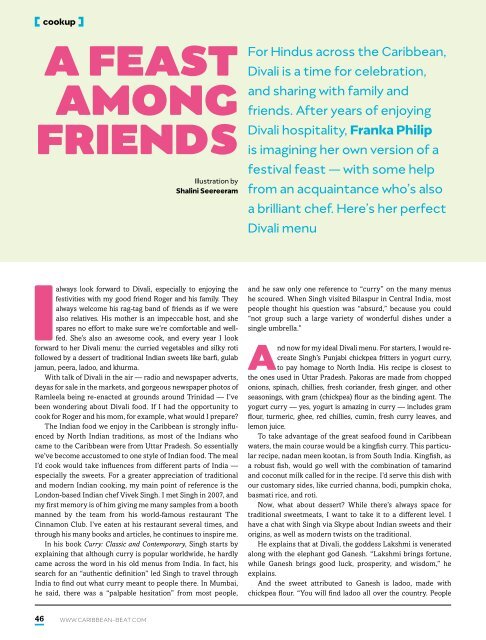Caribbean Beat — November/December 2018 (#154)
A calendar of events; music, film, and book reviews; travel features; people profiles, and much more.
A calendar of events; music, film, and book reviews; travel features; people profiles, and much more.
Create successful ePaper yourself
Turn your PDF publications into a flip-book with our unique Google optimized e-Paper software.
cookup<br />
A feast<br />
among<br />
friends<br />
Illustration by<br />
Shalini Seereeram<br />
For Hindus across the <strong>Caribbean</strong>,<br />
Divali is a time for celebration,<br />
and sharing with family and<br />
friends. After years of enjoying<br />
Divali hospitality, Franka Philip<br />
is imagining her own version of a<br />
festival feast <strong>—</strong> with some help<br />
from an acquaintance who’s also<br />
a brilliant chef. Here’s her perfect<br />
Divali menu<br />
I<br />
always look forward to Divali, especially to enjoying the<br />
festivities with my good friend Roger and his family. They<br />
always welcome his rag-tag band of friends as if we were<br />
also relatives. His mother is an impeccable host, and she<br />
spares no effort to make sure we’re comfortable and wellfed.<br />
She’s also an awesome cook, and every year I look<br />
forward to her Divali menu: the curried vegetables and silky roti<br />
followed by a dessert of traditional Indian sweets like barfi, gulab<br />
jamun, peera, ladoo, and khurma.<br />
With talk of Divali in the air <strong>—</strong> radio and newspaper adverts,<br />
deyas for sale in the markets, and gorgeous newspaper photos of<br />
Ramleela being re-enacted at grounds around Trinidad <strong>—</strong> I’ve<br />
been wondering about Divali food. If I had the opportunity to<br />
cook for Roger and his mom, for example, what would I prepare?<br />
The Indian food we enjoy in the <strong>Caribbean</strong> is strongly influenced<br />
by North Indian traditions, as most of the Indians who<br />
came to the <strong>Caribbean</strong> were from Uttar Pradesh. So essentially<br />
we’ve become accustomed to one style of Indian food. The meal<br />
I’d cook would take influences from different parts of India <strong>—</strong><br />
especially the sweets. For a greater appreciation of traditional<br />
and modern Indian cooking, my main point of reference is the<br />
London-based Indian chef Vivek Singh. I met Singh in 2007, and<br />
my first memory is of him giving me many samples from a booth<br />
manned by the team from his world-famous restaurant The<br />
Cinnamon Club. I’ve eaten at his restaurant several times, and<br />
through his many books and articles, he continues to inspire me.<br />
In his book Curry: Classic and Contemporary, Singh starts by<br />
explaining that although curry is popular worldwide, he hardly<br />
came across the word in his old menus from India. In fact, his<br />
search for an “authentic definition” led Singh to travel through<br />
India to find out what curry meant to people there. In Mumbai,<br />
he said, there was a “palpable hesitation” from most people,<br />
and he saw only one reference to “curry” on the many menus<br />
he scoured. When Singh visited Bilaspur in Central India, most<br />
people thought his question was “absurd,” because you could<br />
“not group such a large variety of wonderful dishes under a<br />
single umbrella.”<br />
And now for my ideal Divali menu. For starters, I would recreate<br />
Singh’s Punjabi chickpea fritters in yogurt curry,<br />
to pay homage to North India. His recipe is closest to<br />
the ones used in Uttar Pradesh. Pakoras are made from chopped<br />
onions, spinach, chillies, fresh coriander, fresh ginger, and other<br />
seasonings, with gram (chickpea) flour as the binding agent. The<br />
yogurt curry <strong>—</strong> yes, yogurt is amazing in curry <strong>—</strong> includes gram<br />
flour, turmeric, ghee, red chillies, cumin, fresh curry leaves, and<br />
lemon juice.<br />
To take advantage of the great seafood found in <strong>Caribbean</strong><br />
waters, the main course would be a kingfish curry. This particular<br />
recipe, nadan meen kootan, is from South India. Kingfish, as<br />
a robust fish, would go well with the combination of tamarind<br />
and coconut milk called for in the recipe. I’d serve this dish with<br />
our customary sides, like curried channa, bodi, pumpkin choka,<br />
basmati rice, and roti.<br />
Now, what about dessert? While there’s always space for<br />
traditional sweetmeats, I want to take it to a different level. I<br />
have a chat with Singh via Skype about Indian sweets and their<br />
origins, as well as modern twists on the traditional.<br />
He explains that at Divali, the goddess Lakshmi is venerated<br />
along with the elephant god Ganesh. “Lakshmi brings fortune,<br />
while Ganesh brings good luck, prosperity, and wisdom,” he<br />
explains.<br />
And the sweet attributed to Ganesh is ladoo, made with<br />
chickpea flour. “You will find ladoo all over the country. People<br />
46 WWW.CARIBBEAN-BEAT.COM


















